Friday, November 6th 2020

Arm Takes Aim at Laptops: Cortex-A78C Processor for PCs Introduced
In the past few years, the Windows-on-Arm (WoA) market has gotten some momentum has with companies trying to develop their WoA PCs, primarily laptops. One example of that is Microsoft. The company has launched a Surface notebook powered by a custom chip from Snapdragon, called Surface Pro X. This device is being powered by the Snapdragon SQ2 processor. However, what seemed to be missing for a while was the lack of support from the Arm itself for this type of market. That is what the company decided to change and make a brand new processor IP dedicated to "on-the-go" devices as they call it, translating into laptops.
The Cortex-A78C is a new design direction which Arm thinks is a good way for laptops, to get some more serious work done. Unlike the regular Cortex-A78 which is a heterogeneous design of big and little cores (Arm's famous big.LITTLE architecture), the new Cortex-A78C revision aims to change that. The "C" version of the processor is actually a homogeneous structure made up of all the big cores. Where you would typically use four big and four little cores for a design, Arm has decided to go all big with this design. For multithreaded purposes, this is the right decision to boost performance. The level three (L3) cache has seen a boost as well, translating to 8 MB of L3$ found on the die. We are eagerly awaiting to see the first designs based on this configuration and see how it performs.
Source:
Arm
The Cortex-A78C is a new design direction which Arm thinks is a good way for laptops, to get some more serious work done. Unlike the regular Cortex-A78 which is a heterogeneous design of big and little cores (Arm's famous big.LITTLE architecture), the new Cortex-A78C revision aims to change that. The "C" version of the processor is actually a homogeneous structure made up of all the big cores. Where you would typically use four big and four little cores for a design, Arm has decided to go all big with this design. For multithreaded purposes, this is the right decision to boost performance. The level three (L3) cache has seen a boost as well, translating to 8 MB of L3$ found on the die. We are eagerly awaiting to see the first designs based on this configuration and see how it performs.

21 Comments on Arm Takes Aim at Laptops: Cortex-A78C Processor for PCs Introduced
Patiently waiting for ARM processors in ATX format (either embedded with mobo or socketed).
Of course all of those details are hidden from users so people assume their phones are just a bunch of under powered POS.
Neither Apple Neural Engine nor the Qualcomm Hexagon are ARM. They're dedicated FPU coprocessors for all those photography effects. They exist inside of the SoC, but they have their own instruction sets.
---------
ARM has decent FPU performance for its size. But nothing like a dedicated DSP, GPU, or even desktop-class CPU-SIMD unit like AVX on Zen3. Those dedicated DSPs are no joke though: and they have incredibly tight power requirements.
While Apple's neural engine seems closed, the Qualcomm Hexagon is decently open (or at least, has more open documentation). developer.qualcomm.com/software/hexagon-dsp-sdk
developer.qualcomm.com/download/hexagon/hexagon-dsp-architecture.pdf
EDIT: VLIW, wow. I forgot there were VLIW systems still being made, lol. Well, there we go, VLIW is super-mainstream, in every single Qualcomm Snapdragon product for the purposes of camera sensor processing. I knew about Hexagon, but I didn't read any of the details till now...
Furthermore: X1 doesn't really exist yet. This A78c is a much smaller chip than the X1 (and also doesn't exist yet). If we're comparing something like a current Apple A14 or a Snapdragon 875, we still need to go back a few generations to Zen1 (or Sandy Bridge on Intel) for comparable FPU performance.
and today mobile stuffs has better power and good at processing heavy task like video editor, photography etc
it's interesting how far ARM could drive the other platform (notebook), if they are pretty good or at least offering better power/performance ratio than today processor, why not
Those four pipelines can do four simultaneous things. For example, FP Multiply can be done on P0 and P1, while FP Add can be done on P2 and P3. See Agner Fog's manual, section 20.10 ("Floating point execution pipes") for Zen1 / Zen+ details. Citation: www.agner.org/optimize/microarchitecture.pdf (Currently page 217, but I know that manual's page number changes as it gets updated).
I think Intel is just experimenting with the platform, and they want to "capture" the technology. Whether or not Adler Lake is a successful product is of no relevance: Intel just needs to make something for the sake of engineering.
Alder Lake-S is called a desktop processor in all the sources I know, slotting into the new LGA1700 platform. Lakefield is the one for laptops which is already available.
That's very odd to me. I can't imagine why a Desktop class processor would want atom-cores. EDIT: Maybe there's a segment of power-efficient desktops that Intel is focusing on? Like the NUC or something? I'd still find it strange to call NUC-class processors a "Desktop" however.